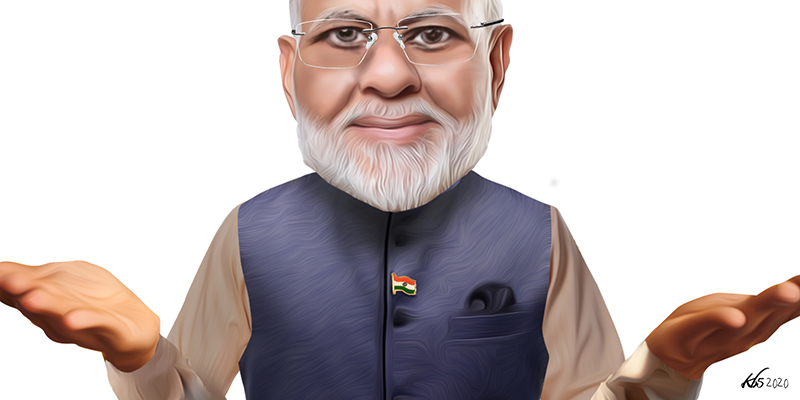A majestic sweep of red sandstone buildings housing government ministries overlooking manicured green lawns and an avenue slicing its way to a lonely war monument. To its left is Parliament House (shaped like a wheel on its side), stately administrative buildings and the National Archives. This landscape of restrained opulence – known as the Central Vista – was designed by the British when they decided to move their imperial headquarters from Calcutta (or Kolkata as it is now called) to Delhi in 1911. It seems to reach further back, however, drawing its monumental presence from a hoary, indeterminate past and projecting it into the eternal future, a timeless performance of power.
In all likelihood this historic, internationally renowned architectural panorama will look very different by the time India’s 75th anniversary in August 2022 rolls around if the Indian Prime Minister Narendra Modi’s plan to redesign it goes ahead as planned. The $2.7 billion project was green-lighted recently by the housing ministry amid widespread consternation. Urban planners, architects, designers, artists, journalists, scholars and politicians deplored the extravagance amidst a pandemic and alleged favouritism in the choice of a consultant and raged against the government’s cavalier approach to history and aesthetics.
The liberal intelligentsia does not trust Narendra Modi. The mistrust can be traced back to 2002 when mass attacks killed over a thousand Muslims in the western state of Gujarat where Modi, a member of the militant Hindu Rashtriya Swayamsevak Sangh (RSS), was chief minister. The riots pointed to a bleak future for India’s secular ethos in the event of a full-fledged majoritarian dispensation. That prediction was put to a test in 2014 when Modi, repackaged as a hyper-capitalist moderniser by a $700 million election campaign, stormed the national ballot. The national media claimed that he had left his divisive past behind him and had worked a developmental miracle in Gujarat, a phenomenon it termed the “Gujarat Model”.
Any hope that the liberal intelligentsia may have drawn from this turn has been belied by Modi’s performance as prime minister. The economy has weakened while a controversial amendment to the Citizenship Act has been passed accompanied by continued attacks on Muslims, lower caste Hindus, human rights activists and students.
Sensitive Indians are appalled by the widespread and avoidable suffering caused by Modi’s proclivity for dramatic announcements, such as an overnight demonetisation and a sudden lockdown, which sent India’s cash-reliant economy into a tailspin and caused thousands of migrants living in cities to walk hundreds of miles to their home villages.
Astute political analysts are thrown by Modi’s arbitrary and unpredictable diktats, which include immensely significant decisions, such as revoking Jammu and Kashmir’s special status within the Indian Constitution. Modi’s effusiveness in greeting foreign leaders, his love for the media glare and his penchant for buying bullet trains and building gigantic statues have provoked ridicule. The Central Vista project had one commentator comparing him to a mid-20th century African autocrat with a vanity project; another compared him to Mungerilal, a 1980s Indian television soap opera character based on the chronic daydreamer, Walter Mitty.
Sensitive Indians are appalled by the widespread and avoidable suffering caused by Modi’s proclivity for dramatic announcements, such as an overnight demonetisation and a sudden lockdown, which sent India’s cash-reliant economy into a tailspin and caused thousands of migrants living in cities to walk hundreds of miles to their home villages.
A picture emerges of a fanatical, capricious and megalomaniacal leader; a self-aggrandising man who is so consumed by bigotry that it is impossible to know what he will do next. It is a compelling image but it is a myth.
I say this because I spent many years observing Modi when he was chief minister in his home state. As a frequent visitor to Gujarat in the early 2000s, I noticed that in its preoccupation with the mass violence of 2002 and the ensuing judicial processes, the national media was unaware of other significant events in the state. First was the deep and unusual consensus of hostility rather than empathy among local Hindus towards Muslim riot victims. Second was the way Modi had leveraged the fraught post-riot environment to garner support across communities in the entrepreneurial state for a fast-track development effort concentrated on Gujarat’s commercial capital, Ahmedabad. Every few months I found that something new – a luxury hotel, a convention centre, roads, a highway – had been added. A modest city was remodelled into a mega metropolis and a site for attracting investment through a splashy biannual summit under the tagline “Vibrant Gujarat”.
I sensed that these phenomena had national implications and I was proved right when Modi surged to power at the centre in 2014 on the basis of his achievements in Gujarat. The problem was that nobody understood what exactly Modi had done in Gujarat or how well it explained his current game plan for India.
A New India
Since 1991, when India adopted capitalist reforms, there has been a promise in the air of a new India, a country equipped with the infrastructure, material opportunities and consumer goods of the developed world. Eager Indians have looked forward to surging riches and cities with the gleam of Shanghai and Singapore, the promised fruits of an accelerated urbanisation programme that has a wide and uncontested acceptance across the political spectrum.
The absence of a palpable concern for the high human cost of restructuring in a poor country like India testifies to the blinding appeal of these material aspirations. Or perhaps it is the malleable nature of Indian politics and the responsiveness of politicians to pulls and pressures (a quality deplored for slowing down change but critical in a democracy) that have led thoughtful voters to assume that an incremental process would find ad hoc solutions along the way.
However, Narendra Modi is not a conventional Indian politician. In fact, he is not a politician at all. He is an ideologue. He is committed to the ideology of the RSS. And he is committed to neoliberalism. And he is committed to both at the same time. The binary created in 2014 by the media that claimed that Modi had relinquished his divisive past to embrace development is a false one. The two are not contradictory but symbiotic.
To explain this amalgam I need to say a little about Modi’s developmental strategy in Gujarat. The media in 2014, in its superficial understanding of what it called the “Gujarat Model”, painted a picture of a high-growth neoliberal model (albeit with poor indices on conventional measures, such as health and nutrition). Had the media done a more in-depth study or looked at available scholarship on the subject, it would have found that the phenomenon they were touting was not a random collection of developmental projects but facets of a highly-evolved process used all over the world by neoliberalising economies.
However, Narendra Modi is not a conventional Indian politician. In fact, he is not a politician at all. He is an ideologue. He is committed to the ideology of the RSS. And he is committed to neoliberalism. And he is committed to both at the same time.
Place marketing is a process of making spaces, particularly cities, attractive to people and companies with money to spend, particularly transnational corporations, business travellers and tourists. A number of strategies are associated with the process, the most common of which is gentrification. Airports are made over, cities are beautified, special business enclaves and recreational areas with nightclubs and cafés spring up.
There are several other strategies that cities use to market themselves, including staging large cultural events, developing historical enclaves to attract tourists or fostering a service or industrial specialisation. Ahmedabad was imagined as a centre for medical tourism and its old walled city was refurbished to bid for UNESCO World Heritage certification. Indeed one can find every place marketing strategy represented in the city as if someone had ticked off a list in a textbook.
Neoliberalism, which targets developmental activities at moneyed sections of society in the expectation that the benefits will “trickle down” to the deprived masses, is a highly iniquitous form of development. In societies across the world, it has also been noticed that neoliberalism’s adverse effects are felt most strongly by those lower down the social ladder. The RSS’s goal of privileging Hindus fits in well with the hierarchical arrangement. Modi’s innovation was to insert a feature of the RSS agenda into every opportunity thrown up by the makeover effort.
So in a city where the 2002 riots had seen Muslims from mixed areas relocate to ghettos on the margins, a new High Street emerged, bursting with malls, multiplexes, restaurants and replicas of Hindu temples from every part of the country. An artificial lake built by a 15th century sultan and frequented by the poor labouring class metamorphosed into a walled pay-and-use leisure space with a toy train running around the periphery. In a city where Gandhi, an advocate of non-violence and a bête noire of militant Hinduism, had his most visited ashram, a heritage walk described a legacy of violence in the freedom struggle. Even the city’s name underwent a spelling change to rid it of its Islamic associations.
Scaling up the Model
It is a hard argument to push in a country obsessed with personalities and electoral battles, but here it is: Modi is not a 20th century despot but a contemporary leader like Turkey’s Erdogan and Brazil’s Bolsonaro. His thinking is not arbitrary but formulaic. It can be summed up as: Place marketing conflated with RSS goals against the backdrop of neoliberalism and a narrative combining stigmatisation with hyperbole. Though varying situations and opportunities may throw up qualitatively differing outcomes, the formula remains the organising principle.
Viewed through this lens, various phenomena, such as Modi’s frequent foreign visits, his “Make in India” and similar campaigns to encourage manufacturing activities, and his passion for the bullet train (a shiny symbol of speed) are activities easily associated with a place marketing exercise.
All his political moves and programmes, including demonetisation, schemes like the Pradhan Mantri Jan Dhan Yojana to expand the reach of banking and even huge political leaps, such as the move on Jammu and Kashmir, become steps (ordering, enumerating, expanding opportunity, extending the formal economy) in a project of neoliberal transformation. Some borrow directly from Gujarat: the 2014 Swachh Bharat or Clean India mission extended the logic of a 1997-1998 USAID programme in Ahmedabad to improve hygiene and create green spaces to aid the circulation of capital and healthy labour.
The relentless violence and aggression that have marked Modi’s prime ministership are not ends in themselves but tactical manoeuvres to accelerate the process of economic restructuring by distracting or deflecting potential opposition, as well as creating a miasma of fear that empowers Modi to restructure with minimal blowback. Modi’s majoritarian inclinations are an essential component of the process but their main vehicle is not the sporadic bursts of violence but more enduring forms made possible by the project of remaking.
Configuring urban space
Urban space and architecture have a critical role to play in place marketing. In recent times, cities have vied to attract attention by building the biggest, shiniest, tallest or most eye-catching structures. Kaula Lumpur’s Petronas Towers (the world’s tallest building when it was built) was showcased by the Malaysian government in a 1999 Fox film starring Sean Connery and Catherine Zeta Jones as a form of “state-sponsored architectural nationalism”. The London Eye, or the Millennium Wheel, billed as Europe’s tallest cantilevered observation wheel when it was launched in 2000, attracts 3.75 million visitors annually.
Modi is drawn to scale. Publicity material for the Gujarat International Finance Tec-City on the banks of the Sabarmati in Ahmedabad claimed it would be twice the size of Paris’ La Defense and eight times more built up than the London docklands. Nearby Surat is building the world’s “largest diamond bourse”. Modi’s pet project as Prime Minister, a Statue of Unity that is 182 metres high and a tourist attraction, is another instance of a project defined by place marketing canons. The statue, which is of Sardar Patel, India’s first Deputy Prime Minister, and a favourite of the Hindu Right, also demonstrates perfectly Modi’s habit of conflating a neoliberal aim with a majoritarian one.
His thinking is not arbitrary but formulaic. It can be summed up as: Place marketing conflated with RSS goals against the backdrop of neoliberalism and a narrative combining stigmatisation with hyperbole.
This sort of conflation, while integral to Modi’s vision, is not unknown in place marketing efforts in other parts of the world. In South-East Asia, for instance, amidst the glossiness of skyscrapers, parks, waterways and convention centres, the “post-colonial enterprise of cultivating national identity and promoting national pride remains highly salient”, according to urban scholar B. S. A. Yeoh. It can be seen in the incorporation of Asian elements like the Hindu mandala and Chinese ideas of Feng Shui, Yin-and-Yang and in other more subtle ways that promote the conjoined values of entrepreneurialism, consumerism and nationalism.
Framed against this backdrop, the Central Vista project does not emerge as a maverick’s vanity project but as a symbolic assertion of a new idea of India that draws not only from religious triumphalism but also, and importantly, from multiple well-funded programmes of urban regeneration and the immense hunger for an India that is dressed in the superficial glamour of the West. Housing ministry officials who talk about replacing historical buildings with “world class” infrastructure speak from a script that acknowledges that the “global”, as P. F. Kelly points out, “has become an icon or a spatial metaphor…with considerable political power”.
By ignoring the socio-cultural impact of economic policy shifts both globally and in post-liberalisation India, and focusing exclusively on conventional politics, the Indian liberal intelligentsia is failing to mount a meaningful critique of the contemporary Indian political scenario, thus presenting Modi with the opportunity of a fait accompli.








